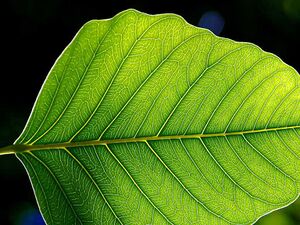Earth:Primary producers

Primary producers convert an abiotic source of energy (e.g. light) into energy stored in organic compounds, which can be used by other organisms (e.g. heterotrophs). The primary producers can convert the energy in the light (phototroph and photoautotroph) or the energy in inorganic chemical compounds (chemolithotrophs) to build organic molecules, which is usually accumulated in the form of biomass and will be used as carbon and energy source by other organisms (e.g. heterotrophs and mixotrophs). The photoautotrophs are the main primary producers, converting the energy of the light into chemical energy through photosynthesis, ultimately building organic molecules from carbon dioxide, an inorganic carbon source. [1] Examples of chemolithotrophs are some archaea and bacteria (unicellular organisms) that produce biomass from the oxidation of inorganic chemical compounds, these organisms are called chemoautotrophs, and are frequently found in hydrothermal vents in the deep ocean. Primary producers ares at the lowest trophic level, and are the reasons why Earth is sustainable for life to this day [2].
Examples
There are many different types of primary producers in the Earth's ecosystem at different states. Fungi and other organisms that gain their biomass from oxidizing organic materials are called decomposers and are not primary producers. However, lichens located in tundra climates are an exceptional example of a primary producer that, by mutualistic symbiosis, combine photosynthesis by algae (or additionally nitrogen fixation by cyanobacteria) with the protection of a decomposer fungus. Also, plant-like primary producers (trees, algae) use the sun as a form of energy and put it into the air for other organisms.[1] There are of course H2O primary producers, including a form of bacteria, and phytoplankton. As there are many examples of primary producers, two dominant types are coral and one of the many types of brown algae, kelp.[1]
Photosynthesis
Gross primary production occurs by photosynthesis. This is also a main way that primary producers take energy and produce/release it somewhere else. Plants, coral, bacteria, and algae do this. Bacteria is a more recent find in the process of photosynthesis with primary producers, as they were just[when?] discovered in the soil. During photosynthesis, primary producers take energy from the sun and produce it into energy, sugar, and oxygen. Primary producers also need energy to convert this same energy elsewhere, so they get it from nutrients. One type of nutrient is nitrogen.[2][1]
Importance of primary producers
Without primary producers, organisms that are capable of producing energy on their own, the Earth would be unable to sustain itself.[1] Plants, along with other primary producers, produce the energy that beings consume, and the oxygen that they breathe.[1]
It is thought that the first organisms on Earth were primary producers located on the ocean floor.[1]
Primary production in tropical streams and rivers
Aquatic algae are a significant contributor to food webs in tropical rivers and streams. This is displayed by net primary production, a fundamental ecological process that reflects the amount of carbon that is synthesized within an ecosystem. This carbon ultimately becomes available to consumers. Net primary production displays that the rates of in-stream primary production in tropical regions are at least an order of magnitude greater than similar temperate systems.[3]
References
- ↑ 1.0 1.1 1.2 1.3 1.4 1.5 1.6 "What Are Primary Producers?" (in en). https://sciencing.com/primary-producers-8138961.html.
- ↑ 2.0 2.1 Post, David M (2002). "Using Stable Isotopes to Estimate Trophic Position: Models, Methods, and Assumptions". Ecology 83 (3): 703–718. doi:10.1890/0012-9658(2002)083[0703:USITET2.0.CO;2].
- ↑ https://www.sciencedirect.com/topics/agricultural-and-biological-sciences/primary-production[full citation needed]
External links

